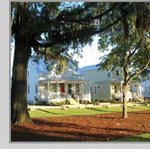 As promised, I'll be starting a five-part series reviewing the urbanism and smart growth aspects of the EastChase development in East Montgomery. And, while the series will focus on EastChase (primarily because it's in the River Region and this is a River Region-focused blog), this critique is not limited to this single development but, rather, applies to this type of "lifestyle center" in general.
As promised, I'll be starting a five-part series reviewing the urbanism and smart growth aspects of the EastChase development in East Montgomery. And, while the series will focus on EastChase (primarily because it's in the River Region and this is a River Region-focused blog), this critique is not limited to this single development but, rather, applies to this type of "lifestyle center" in general.First things first though. My goal with this series is not to denigrate EastChase in general. Indeed, the project does have some redeeming qualities (such as bringing many new retailers to the area that weren't here before). Instead, the ultimate goal is to explain what EastChase is...and is not.
For starters, it is a shopping center.
It is not a main street or town center of any type.
Now, I suspect some of you are thinking, "Well, duh!"
But, wait. Before you do that, realize this. There are many people who think that EastChase is just that--a main street (or, as I've personally heard before, the Main Street of East Montgomery). In just a moment we'll look at why that is incorrect. First, back to the is/is not part.
EastChase is a mono-use commercial project.
It is not a sustainable growth or smart growth development.
I suspect that statement has far fewer "Well, duhs"...hold that thought though because we'll deal with this one later.
For now, I want to focus on why EastChase is not a main street or town center by any stretch of the reasonable imagination.
To do so, let's consider what a main street really is--or, better stated, what makes a main street.
First, people shop on a main street. They also work there. And live there, too.
Often, they worship there. Recreate there.
Gather together for fun. Or sometimes to protest.
In other words, a main street or town center--by its very nature--is not used only for a single thing (i.e. it is not mono-usage).
Another feature about a main street or town center is that there is a mix of public and private property. Private shops, lofts, homes, offices and the like. Together with public sidewalks, parks, and civic buildings. Resulting in a finely-grained mixture of public and private spaces.
Now, needless to say, this is just a short primer on what makes a main street. And it certainly doesn't apply to every single main street or town center anywhere. That said though, these features are shared by the vast majority (if not 99%) of main streets and town centers.
So, why is this important, you ask?
Simple, really.
Compare the classic characteristics of a main street or town center with EastChase and you'll quickly see that EastChase shares very little in common with them.
It's mono-usage. No residences of any type. No public property at all. And, for at least the "lifestyle center" part of it, not even any offices.
Sure, people shop there. But do they live there? Recreate there (in a non-retail sense)? Gather for public events?
Well, if you really look carefully, the answer is no, no, and no.
Why?
Because, EastChase is a private shopping center. It's goal is to make money for private companies. Which, of course, is perfectly fine.
Except when it intimates that it is anything other than just a differently-organized shopping mall--no different in ultimate format than Festival Plaza or Eastdale Mall or even Montgomery Mall.
So, in analyzing EastChase (and lifestyle centers in general), let's first understand what it is: a privately-owned retail center that--while its architecture, design, and marketing may attempt to evoke the emotions of a main street (right down to the bronzed statutes of kids playing with their dog--a curious site because, as we'll discuss in later part, nearly all animals are expressly prohibited from EastChase) is not a town center or main street in any real discernible way.
Understanding this key point is critical as it serves as the starting point for the next parts of this series which will examine why--whether it is the design, usage, or other aspects of EastChase--that the project not only is not a main street...but also is not a smart, sustainable growth project.
We'll discuss that next week.
Of course, if you have any comments of any type, feel free to email me at cemerson@faulkner.edu.
Thanks.


1 comment:
This is very true, Chad. Any place that doesn't even supply a sidewalk for pedestrians throughout the development cannot be called "smart" by any means. The closest thing the city has to a "main street"--as it was in the past--is Dexter Ave.
Post a Comment